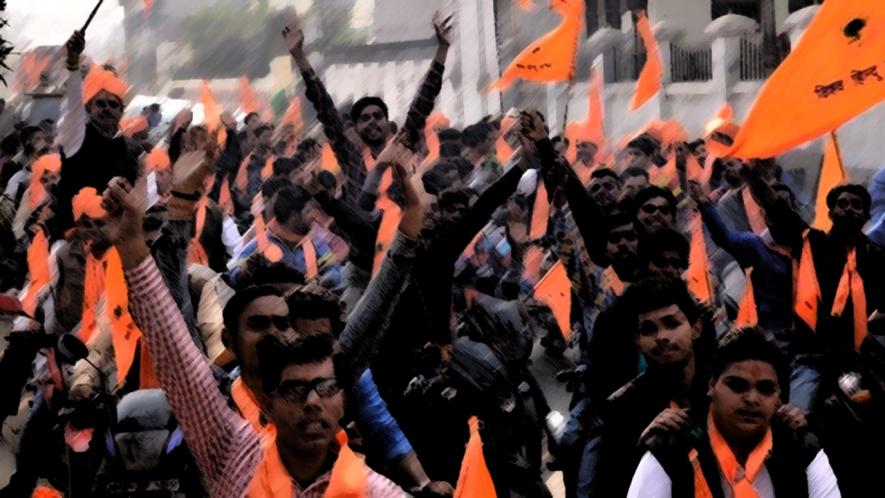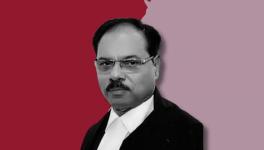Reflections on How to Fight Hindutva

Representational image. | Image Courtesy: Scroll.in
Hindutva is a strange animal, quasi-real, and quasi-manufactured. Part of it is optics and part of it is organic. At one level it connects the social and the political, and at another level it disconnects the political from the social. It is partially based on fear, intimidation and violence, while partially it represents a growing social consent. It is both concrete and abstract, it is imagined, hysterical and delusional and therefore, unverifiable but also speaks to the everyday experiences and instituted ‘lay morality’.
It grows with fake news, propaganda and falsification but links to a social reality that is based on real emotions, anxieties and grievances. It reifies existing social identities and the prejudices that come with them but also carves out new identities and undermines the very reality it connects to. Hindutva refers to the essence of a certain cultural ethos but is also deeply ideological in giving the essence a specific kind of majoritarian direction. The fight against Hindutva has to begin by correctly identifying these two separate but interconnected realms. Hindutva is about creating a majoritarian political system that is not just against the minorities (religious or otherwise), but in fact, is against the majority in the sense of bringing everything under control and into a monolithic order.
The fight against Hindutva is complex because it has to look for the correct kind of an entry point, which is not readily available but has to be created by political resistance that includes the majority – which has conflicting interests. Hindutva has `succeeded` by precisely doing this so far.
Also watch: Part 1 : Fake News is Being Used to Whip up Jingoism
To begin with, Hindutva is defined at its core by its anti-Muslim agenda. Though it is not clear as to what it `finally` wishes to do with millions of Muslims. It oscillates between making them secondary citizens, to their purging from India, including fantasising mass migrations, and may be, mass conversions. It has to create a consensus for this, which is not easy in any modern democracy. If one observes closely, Hindutva makes routine concessions about the Muslim we meet in the concrete everyday life. Adherents of Hindutva would say, ‘not every Muslim is bad’, ‘there are many good Muslims’, and ‘there are also Muslims who are nationalists’. This concession is to relate with the everyday experience of knowing and interacting with Muslims. Average Hindu in the street does not suffer from Islamophobia as it is often made out to be. Many would concede they personally know Muslims who are compassionate, helpful and respectful but the problem is with the ‘community’ in the abstract sense. It shifts between a verifiable concrete and a manufactured abstract narrative that is unverifiable.
The abstract, wholesome dislike for the community or everyday communalism is backed by some random events, fake news, and manufactured hatred that needs to be kept up so as not to subside. Even the most hardened of Hindutva supporter would make routine concessions that there is no need to hate all the Muslims, no need to hate them as a community but it is a fight against ‘some elements’ within the Muslims – who are dangerous fundamentalists – which gives the sense of making it concrete. The discourse and political mobilisation oscillates between the concrete and the abstract and the imagined. What is verifiable in the concrete is subverted or negated by an abstract claim about the community, and abstract and wholesome hatred is countered by random but concrete examples, sometime real but most of it manufactured; the ‘Hindu mind’ is kept under suspended animation, never clear and certain about his or her own concrete experience.
Similarly, Hindutva is also about a certain authentic cultural subaltern represented by nativism that has been sidelined by the elite. It is about the authentic core as against a superfluous elite that lives by borrowed or by imitating and aping, mostly ‘Western’ cultural life. Here again, the idea of the elite and the authentic shifts and oscillates between the concrete and the imagined. We do not know who this superfluous elite actually is. It is certainly not the corporate, not the Multi National Corporations, not the political elite constituted by public representatives, and not the social elites constituted by caste Hindus. The empty idea of superfluous elite shifts as per the context, it could be the opposition parties, it could be the entitled Naamdars, it could be those who are corrupt with black money, it could be in effect anybody who opposes the Hindutva brigade. Elite is mostly an abstract and an imagined variable. It is therefore possible for a policy like demonetisation to claim to have cracked down on the corrupt elite we hear about regularly, but the majority has never actually seen them or knows how they look like or what they do. It therefore makes it plausible for Narendra Modi, in course of the campaign in Gujarat to claim that some higher ups met to conspire against him and India, sitting right in the heart of Delhi. It only feeds on the concrete distrust the majority has about the abstract elites. It further makes the imagined elites concrete by communicating in a cultural idiom that is local, everyday and subaltern in its social location. The majority identify the credibility of the claims through the cultural idioms that are familiar, and verifiable.
The fight against Hindutva cannot afford to merely fight the optics and falsity of the claims because it is backed by something verifiable in the concrete. In fact, the more we do that, the more the majority of cultural subaltern get convinced by the claims of the Hindutva, even if they are false. The fight against Hindutva cannot be from the outside, it has to be from within. It has to get to the core structure of how it oscillates between the real and the unreal. It has to be not about `refusal` but about reoccupying the sites that majority think and make sense of in their everyday life, which could include the idea of family, nation, religion, and community. This is not to accept what exists, because much of it includes prejudice and exclusions, but about resignifying what they mean. This cannot be a sanitised secular or a normative process that stands at a distance and self-enclosed but a politics that can carefully shift between the concrete that can subvert the manufactured reality, and an idealism that speaks to the existing reality.
The author teaches at the Centre for Political Studies, JNU. He recently published his book India after Modi: Populism and the Right. The views are personal.
Also read: 'Hindutva Is Waging a War Against Those Whom it Calls Others'
Get the latest reports & analysis with people's perspective on Protests, movements & deep analytical videos, discussions of the current affairs in your Telegram app. Subscribe to NewsClick's Telegram channel & get Real-Time updates on stories, as they get published on our website.























